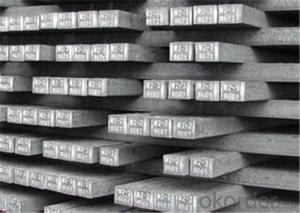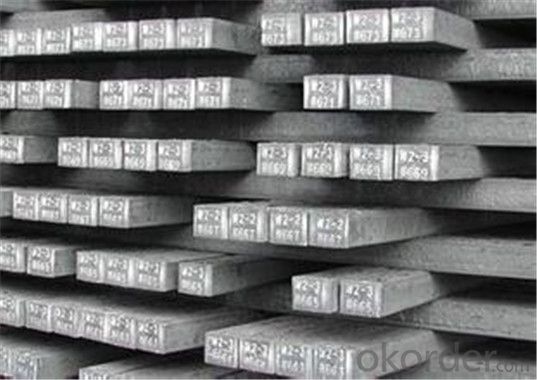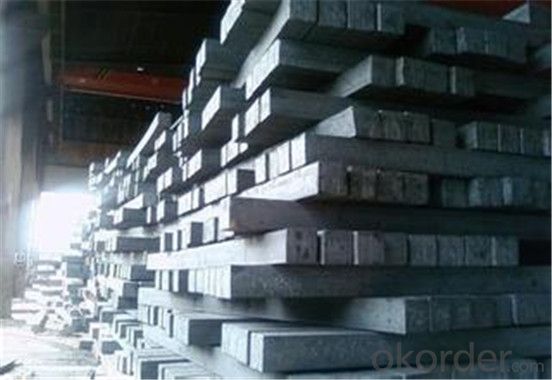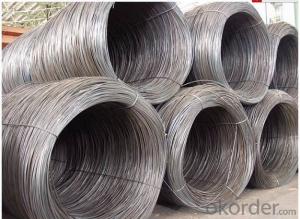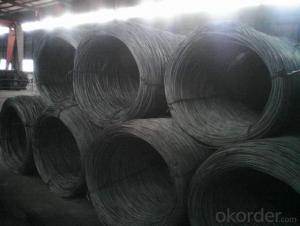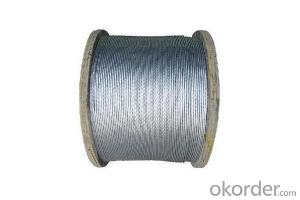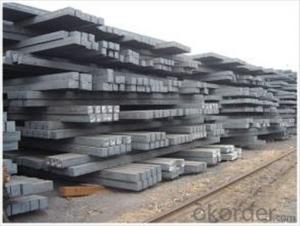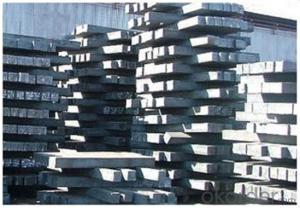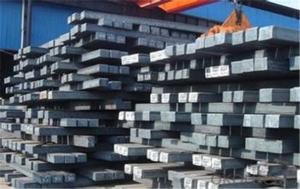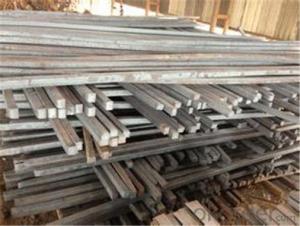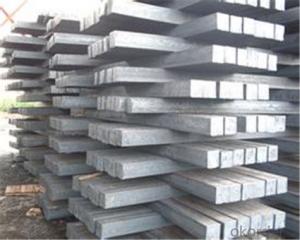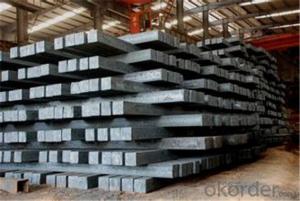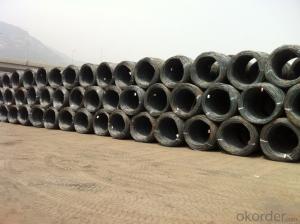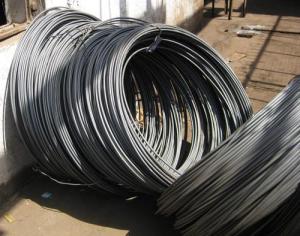Square Steel Billet Hot Sale Q275B/5SP in China
- Loading Port:
- Tianjin
- Payment Terms:
- TT OR LC
- Min Order Qty:
- 600 m.t.
- Supply Capability:
- 45555555 m.t./month
OKorder Service Pledge
OKorder Financial Service
You Might Also Like
Specification
Description of steel billet:
Our company is recognized by ISO9001:2008
1. hot rolled wire rod
2. material: Q195-235
Festures of steel billet:
1. Drawn wire specialist, your wire rod solution
2. ISO9001 Certified Mill &SGS
3. Feature: machinability, high hardness, toughness, corrosion resistant
Specifications of steel billet:
Name: | steel billets |
LENGTH: | 6 meter to 12 meter (+ 50mm) |
Size: | 100*100, 120*120, 150*150, 200*200 |
Grade: | 3SP,5SP,Q235,20MnSi. |
Shape: | Square, Round |
Technique: | Hot-Rolled |
Standard: | ASTM/GB |
BENDING | No more than 5mm in 1 meter |
ANGULAR TWIST | No more than 1 degree per meter and not more than 6 degree over 12 meter length. |
Images of steel billet:
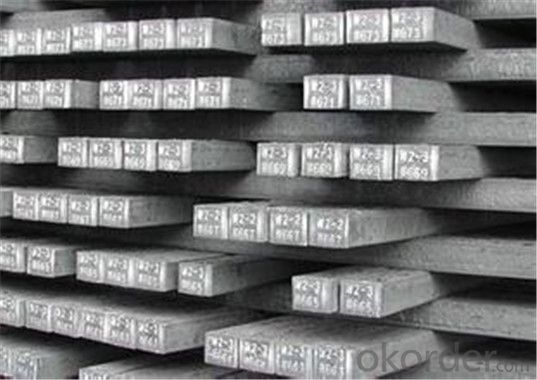
FAQ:
1. What is your package?
Packing situation: standard seaworthy packing or as customer required.
2. How long is the lead time?
Delivery time: 45 days after order confirmed.
3. What payment term do you accept?
Payment: T/T or L/C at sight.
- Q: How is steel wire rod used in the manufacturing of wire forms for material handling?
- Steel wire rod is an essential component in the manufacturing of wire forms for material handling. It serves as the primary raw material that is transformed into various wire forms such as hooks, loops, and coils, which are widely utilized in material handling applications. The process begins with the steel wire rod being subjected to various manufacturing techniques such as drawing and rolling. These processes help to refine and shape the steel wire rod into the desired dimensions and properties required for material handling applications. The resulting wire is then further processed and treated to enhance its strength, durability, and resistance to corrosion. Once the steel wire rod has been transformed into wire forms, it is used in a multitude of ways within material handling equipment. For instance, wire forms are commonly used to create hooks that are attached to lifting devices such as cranes or hoists. These hooks provide a secure and reliable means of lifting and transporting heavy loads. Additionally, wire forms can be shaped into loops that are utilized as handles or gripping mechanisms on material handling tools and equipment. These loops enable operators to safely manipulate or control the movement of objects during material handling processes. Wire forms can also be coiled into springs that are employed in various material handling applications. These springs provide flexibility, shock absorption, and resistance to deformation, thereby ensuring the smooth and efficient operation of material handling equipment such as conveyor systems. In summary, steel wire rod is a fundamental component used in the manufacturing of wire forms for material handling. Through various manufacturing processes, steel wire rod is transformed into hooks, loops, and coils that are crucial for lifting, gripping, and controlling objects during material handling operations. The versatility and durability of wire forms make them indispensable in a wide range of material handling applications.
- Q: What are the different ductility testing methods for steel wire rod?
- There are several ductility testing methods available for steel wire rod. These methods are used to measure the ability of the material to deform under tensile stress without breaking. Some of the common ductility testing methods for steel wire rod include the following: 1. Tensile Test: This is the most common method used to assess the ductility of steel wire rods. In this test, a specimen of the wire rod is subjected to a gradually increasing tensile force until it breaks. The elongation and reduction in area of the specimen are measured, which provide valuable information about the ductility of the material. 2. Bend Test: This test involves bending a specimen of the wire rod to a specified angle without causing any cracks or fractures. The ability of the material to withstand bending without breaking indicates its ductility. The angle of bending and any visible defects are recorded to evaluate the ductility properties. 3. Cupping Test: This test is performed to determine the deep-drawing quality of steel wire rods. A specimen is placed over a die and a punch is used to deform it into a cup shape. The ability of the material to undergo deformation without cracking or tearing indicates its ductility. 4. Charpy Impact Test: While primarily used to measure the toughness of materials, the Charpy impact test is also indicative of the ductility of steel wire rods. In this test, a notched specimen is subjected to a high-velocity impact from a swinging pendulum. The energy absorbed during fracture is measured, and if the material exhibits high energy absorption, it suggests good ductility. 5. Fatigue Test: This test is used to assess the fatigue resistance of steel wire rods, which indirectly indicates their ductility. The specimen is subjected to repeated cyclic loading, and the number of cycles required for failure is recorded. A material with high ductility is expected to have better fatigue resistance. These testing methods provide valuable information about the ductility properties of steel wire rods, helping engineers and manufacturers select the appropriate material for specific applications.
- Q: How is steel wire rod used in the manufacturing of wire forms for lighting fixtures?
- Steel wire rod is used in the manufacturing of wire forms for lighting fixtures as it serves as the primary raw material for creating various wire shapes and designs. The wire rod provides the necessary strength, durability, and malleability required for bending, twisting, and shaping the wire into the desired form. It is commonly used to create intricate structures such as lampshades, frames, and decorative elements, ensuring that the lighting fixtures are sturdy and aesthetically pleasing.
- Q: What are the common industry standards for steel wire rod distributors?
- The common industry standards for steel wire rod distributors include complying with international quality and safety standards such as ASTM (American Society for Testing and Materials), ISO (International Organization for Standardization), and AISI (American Iron and Steel Institute) specifications. These standards define the chemical composition, mechanical properties, dimensions, and other essential characteristics of steel wire rods to ensure consistency and reliability in their usage across various industries.
- Q: What are the different types of steel wire rod coatings used for increased hardness?
- There are several types of steel wire rod coatings used for increased hardness, including metallic coatings like zinc, aluminum, and nickel, as well as non-metallic coatings such as ceramic and polymer.
- Q: How are steel wire rods used in the manufacturing of wire brushes?
- Steel wire rods are an essential component in the manufacturing of wire brushes. These rods serve as the base material from which the bristles of the brush are made. The steel wire rods are first drawn through a series of dies to reduce their diameter and increase their length. This process, known as wire drawing, ensures that the wire is of the desired thickness and strength for brush bristles. Once the wire has been drawn, it is then cut into specific lengths, depending on the size of the brush being manufactured. These cut lengths are then inserted into the brush's base, typically made of wood or plastic, and secured in place using various techniques such as stapling or twisting. The steel wire rods used in wire brushes are usually made from high-quality carbon steel, which provides the necessary durability and flexibility required for effective brushing. Additionally, the wire is often coated with a layer of protective material, such as zinc or brass, to prevent corrosion and enhance its longevity. The bristles made from steel wire rods are widely used in various industries and applications. Wire brushes with steel bristles are commonly used for cleaning, deburring, polishing, and surface preparation tasks. They are particularly effective in removing rust, paint, and other stubborn residues from metal surfaces. The strength and resilience of steel wire bristles make them suitable for heavy-duty cleaning and abrasive tasks. In summary, steel wire rods play a crucial role in the manufacturing of wire brushes by serving as the raw material for the bristles. Through wire drawing, cutting, and securing processes, these rods are transformed into durable and effective bristles that are widely used in various industries for cleaning and surface preparation purposes.
- Q: How is steel wire rod used in the production of suspension springs for marine vessels?
- Steel wire rod is used in the production of suspension springs for marine vessels due to its high tensile strength and flexibility. It is first processed into wire coils, which are then formed into springs using specialized machinery. These suspension springs provide support and stability to the marine vessel, absorbing shocks and vibrations caused by waves and rough sea conditions. By using steel wire rod, the suspension springs can withstand the harsh marine environment and ensure reliable performance for the vessel's suspension system.
- Q: How are steel wire rods used in the production of wire mesh?
- Wire mesh production relies heavily on steel wire rods, which play an indispensable role. These rods undergo a process that involves heating them and passing them through dies to achieve the desired wire diameter. Typically, low-carbon steel is used to provide the necessary strength and durability for wire mesh applications. Once the shaping and desired diameter have been achieved, the steel wire rods are introduced into a wire mesh machine. This machine interweaves the individual wires, forming a grid-like pattern. The wire rods are positioned both vertically and horizontally and are mechanically connected at their intersections. The resulting wire mesh finds applications across various industries. It serves as a robust and dependable barrier for fencing and security purposes. Additionally, it is used in construction to reinforce concrete structures, enhancing their strength and stability. Wire mesh also finds utility in industries such as agriculture, mining, and filtration. To ensure the durability and reliability of the final product, the quality of the steel wire rods used in wire mesh production is of utmost importance. It is crucial to select high-quality rods with the appropriate tensile strength and corrosion resistance properties that meet the specific requirements of each application. In conclusion, the production of wire mesh relies on the shaping of steel wire rods to the desired diameter and their subsequent interweaving to create a grid-like pattern. The resulting wire mesh finds diverse applications in industries such as fencing, construction reinforcement, and filtration.
- Q: Can steel wire rod be used in the production of fasteners?
- Certainly, the utilization of steel wire rod is possible in the manufacturing of fasteners. This multi-functional material possesses the capability to fabricate an extensive array of fasteners like screws, bolts, nuts, and rivets. It exhibits remarkable strength and durability characteristics, rendering it appropriate for a wide range of applications necessitating fasteners. Steel wire rod can be effortlessly manipulated, threaded, and molded to produce fasteners of various dimensions and structures. Furthermore, through heat treatment and surface treatment, the corrosion resistance and mechanical properties of steel wire rod can be enhanced, thereby augmenting its suitability for fastener production.
- Q: What are the different types of steel wire rod coatings available?
- There are several types of steel wire rod coatings available, including galvanized coating, zinc-aluminum coating, and epoxy coating.
Send your message to us
Square Steel Billet Hot Sale Q275B/5SP in China
- Loading Port:
- Tianjin
- Payment Terms:
- TT OR LC
- Min Order Qty:
- 600 m.t.
- Supply Capability:
- 45555555 m.t./month
OKorder Service Pledge
OKorder Financial Service
Similar products
Hot products
Hot Searches
Related keywords

